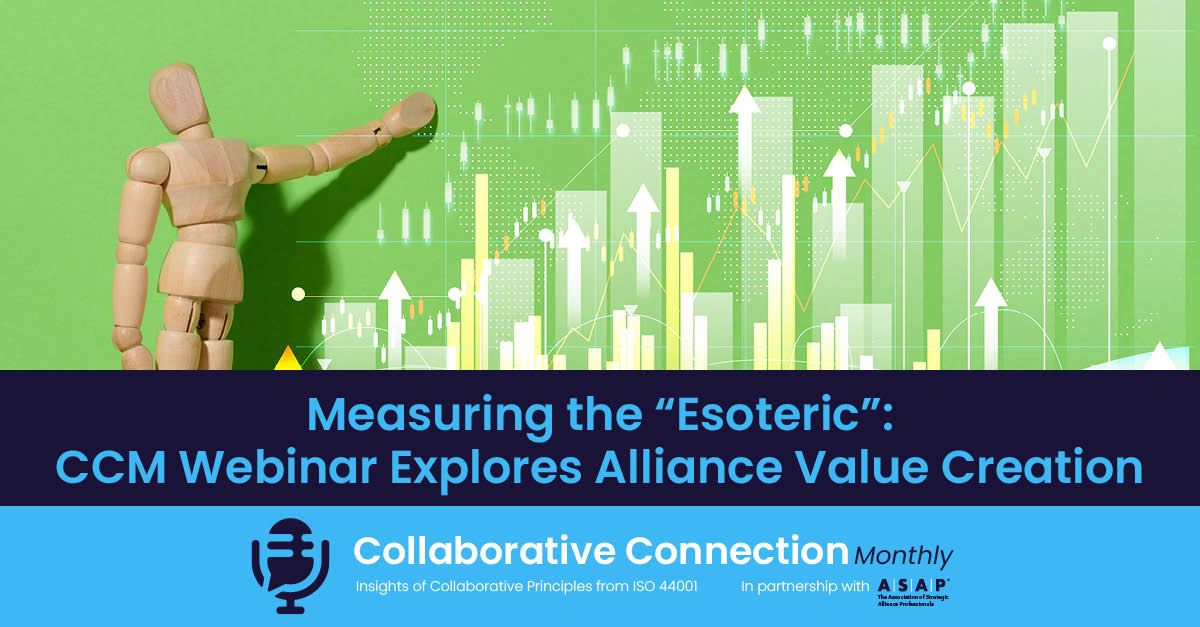Measuring the “Esoteric”: CCM Webinar Explores Alliance Value Creation
Everyone knows that an alliance is nothing—or worse, a net negative—if it isn’t creating value.
“Value creation is the beating heart of great relationships. Without it, your [partnership] is dead on arrival and may never be resuscitated,” said Ann Trampas, CSAP, a professional development practice lead at the Phoenix Consulting Group and a senior lecturer at the University of Illinois–Chicago.
That reality is very simple. However, the path to achieving value, measuring it, and demonstrating it to the rest of the organization is anything but.
To help illuminate and clear the brush impeding the road to value, Trampas was joined by Christina Neary, corporate vice president of Avanade’s global Microsoft alliance, in the latest Collaborative Connection Monthly webinar and roundtable, “The Heart of the Matter: Alliance Value Creation and How to Get There.”
The Right Definition, or the Definition Right Now?
First, there isn’t a single definition of value for a given alliance. Rather, there’s a measure of value for each particular stage or moment in the collaboration. In other words, because client needs, industry trends, and partner roadmaps are constantly changing, so is the picture of what value looks like in the eyes of clients. Alliances and the value they create are a work in progress, much like Neary’s 300-year-old farmhouse, into which she and her husband are perpetually pouring their time, money, and effort.
“I like to recommend that you look at both leading and lagging indicators because what looks like success at the beginning of an alliance may not flow through the later years,” Neary said. “It’s constantly evolving in terms of how do we measure the value and learn from what we’re doing today [while also] thinking about the material impact in the future.”
Live for Today? No: Collaborate for Tomorrow
It’s a fact that’s not lost on customers. When partners show up for a sales pitch or program kickoff, they have pointed questions about both the short- and long-term visions for how technology solutions will boost their overall value propositions.
“Are you just in this for today? What does the horizon one today look like? But what does horizon two and three look like? And how are you going to work together to help us get there? That has really matured our partnering message to clients,” said Neary. “Certainly, they need us to get in and help today, but they also need to know how this increasing investment that they are making in technology will benefit them for where they want to go.”
Clients understand that their own offerings, business processes, and overall organizational agility depend on how well partners design, develop, integrate, and align their joint solutions to their biggest ambitions. When they meet with two or more technology companies, they want to know more than just what they are selling; they try to get a feel for how well they work together.
“A lot of clients are looking for and asking about partnership behaviors—the culture of partnerships and collaboration—as part of RFPs and oral arguments. When you come in and talk about how you want to work with them in the next five years, they want to know, how well do you partner? What are your partnering principles? How agile are you? How do you handle escalations?” said Neary. “That [behavior] has a material impact on clients.”
Come Together and Trust the Process—Right Now!
Which is why for some collaborative initiatives Avanade has incorporated KPIs that measure how the firm and its partners align to help clients adapt to rapidly changing situations.
“What’s new today will be old in six months. So it’s more about, how do we come together quickly? How do we get in front of clients and be able to chart the course with them for where we are all mutually going?” said Neary. She conceded that this is somewhat of an “esoteric measure” that is “hard to put in a scorecard” compared to more-concrete KPIs, such as business and pipeline impact, but Avanade has seen success in making the intangible tangible. “Now, we’re looking at how quickly do we get in front of our clients together? How quickly do our clients decide to move forward together with us? We measure insights that we are gaining…What did we learn and how do we use that in an iterative way and refine our approach? It’s about the process.”
Very soon, the recording of “The Heart of the Matter: Alliance Value Creation and How to Get There” will be available for playback. For those who didn’t catch it the first time, make sure you pull up a seat and find out why Neary believes local teams are pivotal to neutralizing channel conflict.

